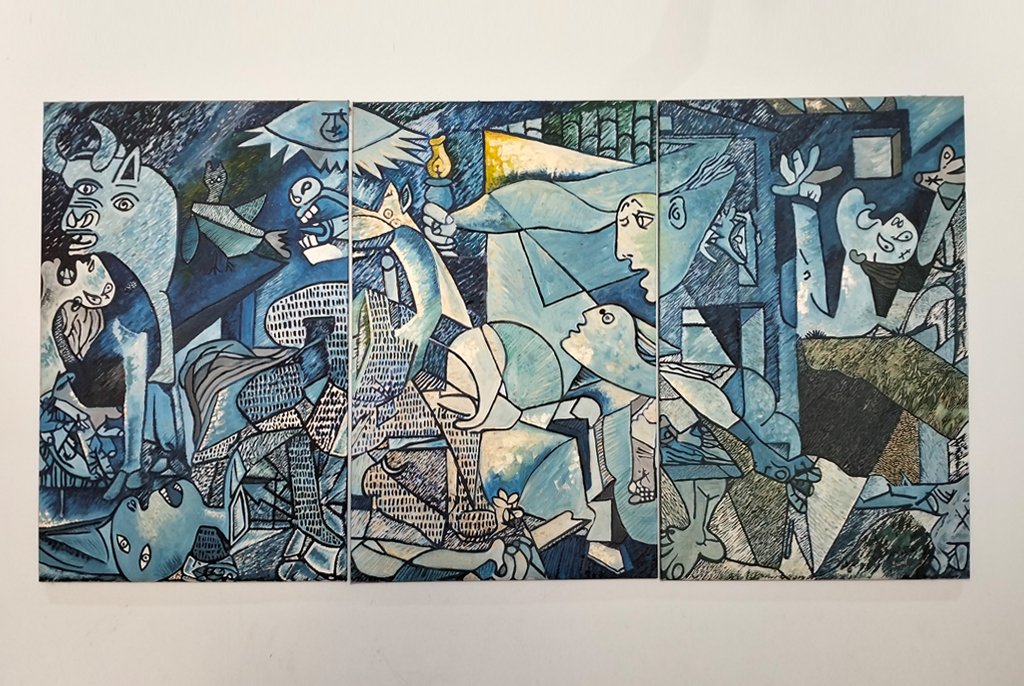Pablo Picasso’s Guernica is more than just a painting; it is a profound statement against the brutality of war and a universal symbol of human suffering. Created in response to the 1937 bombing of the Basque village of Guernica during the Spanish Civil War, this iconic artwork captures the chaos, pain, and devastation inflicted on innocent lives. Through its stark black-and-white palette, fragmented figures, and powerful symbolism, Guernica remains a timeless call for peace and a reminder of the horrors of war.
The Historical Context: The Spanish Civil War and the Bombing of Guernica
The Spanish Civil War: A Nation Divided
The Spanish Civil War (1936–1939) was a brutal conflict between the Republican government, supported by left-wing factions, and the Nationalists, led by General Francisco Franco and backed by Nazi Germany and Fascist Italy. The war was a proxy battle for larger ideological struggles between fascism, communism, and democracy.
The bombing of Guernica on April 26, 1937, marked a turning point in the war. Carried out by German and Italian forces supporting Franco, the attack targeted civilians, reducing the town to rubble and killing hundreds. This act of terror shocked the world and became a rallying cry against fascism.
Picasso’s Inspiration: A Cry Against Injustice
When news of the bombing reached Picasso in Paris, he was deeply moved. Commissioned to create a piece for the 1937 Paris World’s Fair, Picasso abandoned his original plan and instead channeled his outrage into Guernica. The painting was his response to the senseless violence and a plea for global awareness of the atrocities committed during the Spanish Civil War.
Analyzing Guernica: Symbolism, Composition, and Technique
Symbolism in Guernica
Picasso’s Guernica is rich with symbolic imagery:
- The Bull and the Horse: Often interpreted as representations of fascism and the Spanish people, respectively.
- The Grieving Woman: Holding her dead child, she evokes themes of loss and suffering, reminiscent of Christian imagery.
- The Dismembered Soldier: Symbolizing the collapse of Republican resistance.
- The Light Bulb: A dual symbol of hope and destruction, resembling an exploding bomb.
Composition and Technique
Picasso’s use of monochromatic tones (black, white, and gray) creates a stark, haunting atmosphere, emphasizing the chaos and despair of war. The fragmented, overlapping figures and distorted forms reflect the disintegration of life and order during the bombing. The absence of color directs focus to the raw emotion and suffering depicted in the painting.
Guernica as a Symbol of Anti-Fascist Protest
Global Impact and Legacy
When Guernica was unveiled at the 1937 Paris World’s Fair, it immediately captured global attention. The painting transcended its historical context, becoming a universal symbol of anti-war protest and a call to action against fascism. Its exhibition in various countries helped raise awareness of the Spanish Republic’s struggle and mobilized international support.
A Timeless Call for Peace
Today, Guernica remains a powerful reminder of the consequences of war and the importance of peace. Its themes of suffering, injustice, and resistance resonate in contemporary conflicts, making it a relevant symbol for anti-war movements worldwide. The painting continues to inspire artists, activists, and educators, serving as a catalyst for discussions about human rights, democracy, and the fight against oppression.
The Enduring Relevance of Guernica
In a world still plagued by conflict and violence, Guernica stands as a testament to the resilience of the human spirit and the enduring need for peace. Picasso’s masterpiece transcends its historical roots, offering a universal message that speaks to the heart of humanity.


